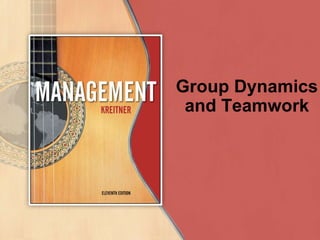
Group dynamics and Team work
- 2. Chapter Objectives • Define the term group. • Explain the significance of cohesiveness, roles, norms, and ostracism in regard to the behavior of group members. • Identify and briefly describe the six stages of group development. • Define organizational politics and summarize relevant research insights. • Explain how groupthink can lead to blind conformity. • Define and discuss the management of virtual teams. • Discuss the criteria and determinants of team effectiveness. • Explain why trust is a key ingredient of teamwork and discuss what management can do to build trust.
- 3. Fundamental Group Dynamics • Social capital: the productive potential of strong relationships, goodwill, trust, and cooperation • What Is a Group? • Two or more freely interacting individuals who share a common identity and purpose • Types of Groups • Informal groups: A collection of people seeking friendship and acceptance that satisfies esteem needs • Formal groups: A collection of people created to do something productive that contributes to the success of the larger organization
- 4. Fundamental Group Dynamics (cont’d) Friendship in the workplace considerations: Bosses being friends with subordinates Putting limits on social media interaction Attraction to Groups Attractiveness of the group Cohesiveness of the group Roles Socially determined ways of behaving in specific positions
- 5. Fundamental Group Dynamics (cont’d) • Norms • Norms are the standards (degrees of acceptability and unacceptability) for conduct that help individuals judge what is right or good or bad in a given social setting. • Norms are culturally derived and vary from one culture to another. • Norms are usually unwritten, yet have a strong influence on individual behavior. • Norms go above and beyond formal rules and written policies.
- 6. Fundamental Group Dynamics (cont’d) • Reasons That Groups Enforce Norms • To facilitate the survival of the group • To simplify or clarify role expectations • To help group members avoid embarrassing situations • To express key group values and enhance the group’s unique identity • Ostracism • Rejection by the group for violation of its norms
- 7. Group Development • Characteristics of a Mature Group • Members are aware of each other’s assets and liabilities. • Individual differences are accepted. • The group’s authority and interpersonal relationships are recognized. • Group decisions are made through rational discussion. • Conflict is over group issues, not emotional issues. • Members are aware of the group’s processes and their own roles in them.
- 8. Six Stages of Group Development • Stage 1: Orientation • Uncertainty about most everything is high. • Stage 2: Conflict and challenge • Subgroups struggle for control; roles are undefined. • Stage 3: Cohesion • Consensus on leadership, structure, and procedures is reached. • Stage 4: Delusion • A feeling of “having been through the worst of it” prevails
- 9. Six Stages of Group Development (cont’d) • Stage 5: Disillusion • Subgroups form with disenchantment, diminished cohesiveness, and diminished commitment to the group. • Stage 6: Acceptance • A trusted and influential group member steps forward and moves the group from conflict to cohesion so that it becomes highly effective and efficient. • Member expectations are more realistic.
- 10. Organizational Politics • What Does Organizational Politics Involve? • The pursuit of self-interest at work in the face of real or imagined opposition • Why Do Employees Use Organizational Politics? • Employees resort to political behavior when they are unwilling to trust their career solely to competence, hard work, and luck. • Whether employees will fall back on political tactics has a lot to do with an organization’s climate or culture.
- 11. Antidotes to Political Behavior • Strive for a climate of openness and trust. • Measure performance results rather than personalities. • Encourage top management to refrain from political behaviors. • Strive to integrate individual and organizational goals through meaningful work and career planning. • Practice job rotation to encourage broader perspectives and understanding of the problems of others.
- 12. Conformity and Groupthink • Conformity is complying with the role expectations and norms perceived by the majority to be appropriate in a particular situation. • Conformity enhances predictability, which is generally thought to be good for rational planning and productive enterprise.
- 13. Teams, Teamwork, and Trust Cross-functional team A task group staffed with a mix of specialists focused on a common objective Virtual team A group of individuals working on tasks from a dispersed location who are electronically linked
- 14. What Makes Workplace Teams Effective? • Innovative ideas • Accomplishment of goals • Adaptability to change • High person/team commitment • Being rated highly by upper management
- 15. Figure 13.6: Trust and Effective Group Interaction
- 16. Summary Managers need a working understanding of group dynamics because groups are the basic building blocks of organizations. After someone has been attracted to a group, cohesiveness—a “we” feeling—encourages continued membership. Mature groups are characterized by mutual acceptance, encouragement of minority opinion, and minimal emotional conflict. Organizational politics centers on the pursuit of self-interest. • Although a fairly high degree of conformity is necessary if organizations and society in general are to function properly, blind conformity is ultimately dehumanizing and destructive. • Teams are becoming the structural format of choice. Today’s employees generally have better technical skills than team skills. • Trust, a key ingredient of effective teamwork, is disturbingly low in the American workplace today.
- 17. Terms to Understand • Social capital • Group • Informal group • Formal group • Cohesiveness • Role • Norms • Ostracism • Organizational politics • Conformity • Groupthink • Cross-functional team • Virtual team • Trust
- 18. THANKYOU